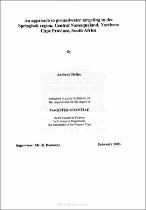| dc.description.abstract | Namaqualand is a semi-arid region where water is not only a necessity and basic need, but also very much a luxury. As a consequence, various studies were undertaken to find water sources, whether surface or groundwater, (by researchers such as DWAF, the University of the Western Cape and other companies such as Toens and Partners), to alleviate water scarcity.
The Springbok region in Central Namaqualand generally comprises intrusives and metasediments ranging in age from 1800 - 1100 Ma. The metasediments are the Okiep group outcropping over the Namaqua Highlands, whilst the intrusives comprise various suites such as the Koperberg Suite (youngest) and the Gladkop Suite being the oldest known intrusive. Gneisses and granites dominate the intrusive rocks. These rocks underwent various deformation phases attributed to different stresses that formed the various structures. The stress field in the area over time has mostly favoured a NWSE direction, the only exceptions being the Gladkop Suite ONNE-SSW), and the Pan- African Nama sediments formed during the Late Proterozoic to early Phanerozoic by an ENE-WSW compressional direction. The Neotectonic stress field in the area is NW-SE. This stress field is set to be part of the Wegener Stress Anomaly. The Neotectonic stress field is important, since it formed the structures e.g. fractures and faults which act as groundwater conduits. Given that the NW-SE stress field had dominated in the past and also is the present day stress field, these fractures are not only favourable for groundwater location, but also saw a variable degree of reactivation since they were already open. Therefore, the NW-SE fractures should be targeted in search of groundwater. The study was dominated by lineament identification and analyses on a regional and local scale using LANDSAT TM 4 and aerial photographs respectively. Structural mapping was undertaken to identify the various fracture orientations, densities and their characteristics in the field. Both the LANDSAT TM 4 and aerial photographs highlighted the following strikes of lineaments: E-w, N-S to NNW, NNE, NE and NW. Field mapping revealed dominant fracture orientations of N-S, E-W, and ESEWNW & ENE-WSW directions. Fieldwork also indicated that the N-S fracture set is actually a fracture system that can be further divided into the NNW-SSE and the NNESSW fracture sets (Nl0-300W) with dyke material having intruded along most of these fractures. Some of the least dominant fractures in the field are the NW-SE & NE-SW fracture sets. On a local scale, water flows from exfoliation surfaces striking N-S with these surfaces fed by other fractures. Lineament analyses using LANDSAT TM 4 revealed that large lineaments direct regional groundwater flow whilst the 1:60 000 aerial photographs showed that smaller lineaments are groundwater carriers locally. Groundwater in Namaqualand is mostly located within the alluvium of rivers, the fractured weathered system of, and within the freshly fractured crystalline basement. The majority of boreholes though, gave significant water in the fractured weathered system; as a result nearly all boreholes were (are) drilled in it. The fractured weathered system is fairly differential but can be up to 80m thick in some boreholes. Boreholes yielding up to 7 Us have been drilled in this weathered fracture system. However current data suggest that large amounts of yielding boreholes are below 100m. The study area is located in the Buffelsriver catchment with groundwater
normally saline and boreholes mostly drilled in structurally controlled valleys. Lower saline waters are found in the higher lying parts of the catchment. The position of fractured aquifers may to a certain extent be reliably predicted by taking in account deformational events and its related stratigraphy, stress fields and its resulting fracture and lineament patterns, as well as topography and weathering patterns. | en_US |

